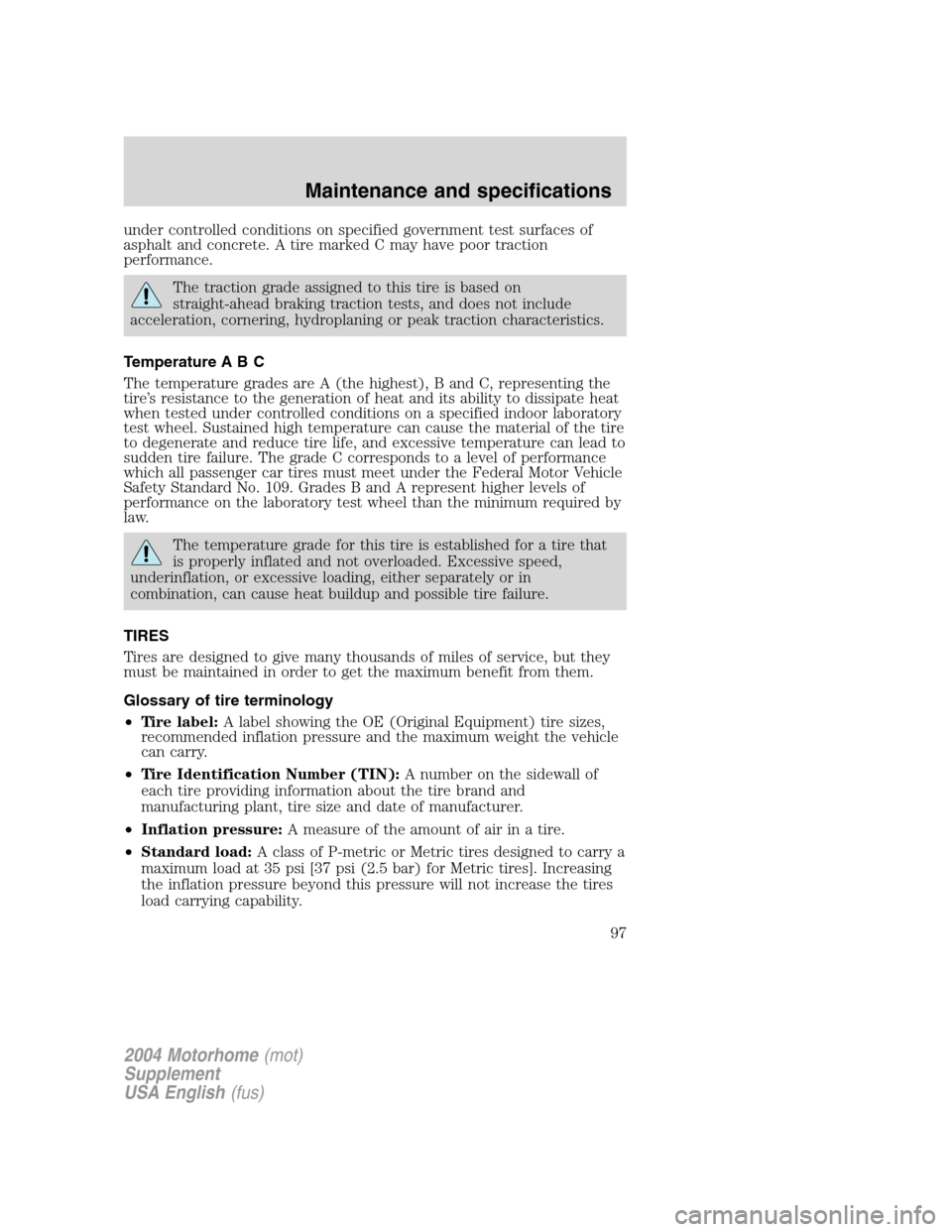Page 97 of 120

under controlled conditions on specified government test surfaces of
asphalt and concrete. A tire marked C may have poor traction
performance.
The traction grade assigned to this tire is based on
straight-ahead braking traction tests, and does not include
acceleration, cornering, hydroplaning or peak traction characteristics.
Temperature A B C
The temperature grades are A (the highest), B and C, representing the
tire’s resistance to the generation of heat and its ability to dissipate heat
when tested under controlled conditions on a specified indoor laboratory
test wheel. Sustained high temperature can cause the material of the tire
to degenerate and reduce tire life, and excessive temperature can lead to
sudden tire failure. The grade C corresponds to a level of performance
which all passenger car tires must meet under the Federal Motor Vehicle
Safety Standard No. 109. Grades B and A represent higher levels of
performance on the laboratory test wheel than the minimum required by
law.
The temperature grade for this tire is established for a tire that
is properly inflated and not overloaded. Excessive speed,
underinflation, or excessive loading, either separately or in
combination, can cause heat buildup and possible tire failure.
TIRES
Tires are designed to give many thousands of miles of service, but they
must be maintained in order to get the maximum benefit from them.
Glossary of tire terminology
•Tire label:A label showing the OE (Original Equipment) tire sizes,
recommended inflation pressure and the maximum weight the vehicle
can carry.
•Tire Identification Number (TIN):A number on the sidewall of
each tire providing information about the tire brand and
manufacturing plant, tire size and date of manufacturer.
•Inflation pressure:A measure of the amount of air in a tire.
•Standard load:A class of P-metric or Metric tires designed to carry a
maximum load at 35 psi [37 psi (2.5 bar) for Metric tires]. Increasing
the inflation pressure beyond this pressure will not increase the tires
load carrying capability.
2004 Motorhome(mot)
Supplement
USA English(fus)
Maintenance and specifications
97
Page 99 of 120

2.215:Indicates the nominal width of the tire in millimeters from
sidewall edge to sidewall edge. In general, the larger the number, the
wider the tire.
3.65:Indicates the aspect ratio which gives the tire’s ratio of height to
width.
4.R:Indicates a“radial”type tire.
5.15:Indicates the wheel or rim diameter in inches. If you change your
wheel size, you will have to purchase new tires to match the new wheel
diameter.
6.95:Indicates the tire’s load index. It is an index that relates to how
much weight a tire can carry. You may find this information in your
owner’s guide. If not, contact a local tire dealer.
Note:You may not find this information on all tires because it is not
required by federal law.
7.H:Indicates the tire’s speed rating. The speed rating denotes the
speed at which a tire is designed to be driven for extended periods of
time under a standard condition of load and inflation pressure. The tires
on your vehicle may operate at different conditions for load and inflation
pressure. These speed ratings may need to be adjusted for the difference
in conditions. The ratings range from 159 km/h (99 mph) to 299 km/h
(186 mph). These ratings are listed in the following chart.
Note:You may not find this information on all tires because it is not
required by federal law.
Letter rating Speed rating - km/h (mph)
Q 159 km/h (99 mph)
R 171 km/h (106 mph)
S 180 km/h (112 mph)
T 190 km/h (118 mph)
U 200 km/h (124 mph)
H 210 km/h (130 mph)
V 240 km/h (149 mph)
W 270 km/h (168 mph)
Y 299 km/h (186 mph)
Note:For tires with a maximum speed capability over 240 km/h (149
mph), tire manufacturers sometimes use the letters ZR. For those with
a maximum speed capability over 299 km/h (186 mph), tire letters ZR.
2004 Motorhome(mot)
Supplement
USA English(fus)
Maintenance and specifications
99
Page 117 of 120

E
Emergencies, roadside
jump-starting ............................52
Emission control system ............88
Engine ................................113–114
cleaning .....................................66
coolant .......................................73
fail-safe coolant ........................77
idle speed control .....................71
lubrication specifications 112–113
refill capacities ........................110
service points ............................68
starting after a collision ...........40
Engine block heater ...................23
Engine oil ....................................69
checking and adding ................69
dipstick ......................................69
filter, specifications ..........70, 109
recommendations .....................70
refill capacities ........................110
specifications ..................112–113
Exhaust fumes ............................23
F
Fail safe cooling ..........................77
Fluid capacities .........................110
Fuel ..............................................79
calculating fuel economy .........84
capacity ...................................110
choosing the right fuel .............81
comparisons with EPA fuel
economy estimates ...................87
detergent in fuel .......................82
filling your vehicle with
fuel .......................................79, 85
filter, specifications ..........82, 109
fuel pump shut-off switch .......40
improving fuel economy ..........84octane rating .............81, 113–114
quality ........................................81
running out of fuel ...................82
safety information relating to
automotive fuels .......................79
Fuses ......................................41–42
G
Gas mileage
(see Fuel economy) ...................84
Gauges .........................................11
GAWR
(Gross Axle Weight Rating) .......31
calculating .................................33
definition ...................................31
driving with a heavy load ........31
location ......................................31
GVWR
(Gross Vehicle Weight Rating) ..31
calculating ...........................31, 33
definition ...................................31
driving with a heavy load ........31
location ......................................31
H
Hazard flashers ...........................40
Headlamps ...................................14
daytime running lights .............14
flash to pass ..............................15
high beam .................................14
turning on and off ....................14
I
Ignition .........................20, 113–114
Inspection/maintenance (I/M)
testing ..........................................89
2004 Motorhome(mot)
Supplement
USA English(fus)
Index
117